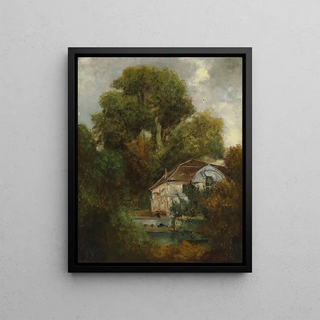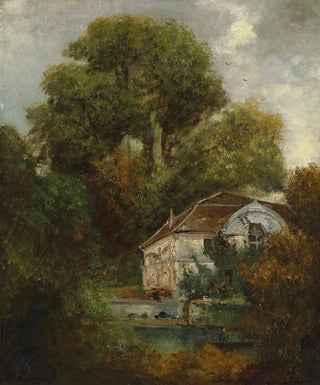Art print | The Château de Beaulieu near Lausanne - Gustave Courbet


View from behind

Frame (optional)
In the vibrant universe of art, some works stand out for their ability to transport the viewer to another time and place. "The Château de Beaulieu near Lausanne" by Gustave Courbet is one of those creations that, through its brushstrokes, evokes an atmosphere filled with serenity and contemplation. Immersing oneself in this art print, one cannot help but feel the magic of an Alpine landscape, where nature and architecture intertwine harmoniously. This painting, a true ode to the beauty of Swiss landscapes, invites us to explore not only the technical mastery of the artist but also the emotion he manages to convey through his works.
Style and uniqueness of the piece
Gustave Courbet, an emblematic figure of realism, stands out for his ability to capture reality in all its complexity. In "The Château de Beaulieu near Lausanne," he deploys a subtle palette of colors, where the deep greens of the trees blend with the soft hues of the buildings. The work is characterized by a balanced composition, where the château, majestic and serene, rises amidst lush nature. The meticulous details of the foliage and reflections on the water testify to attentive observation and mastered technique. Courbet manages to transcend the simple landscape to create a living painting, where each element seems to breathe. This artwork is an invitation to contemplation, a pause in the hustle and bustle of daily life, where the gaze is lost in nuances and textures.
The artist and his influence
Gustave Courbet, born in 1819, is often considered the father of realism. His vision of art, which favors faithful representation of nature and scenes of everyday life, marked a turning point in art history. Moving away from romantic and academic ideals, Courbet paved the way for many artists who followed his example. His frank and direct approach, as well as his commitment to representing the truth, had a lasting impact on the Impressionist movement and beyond. "The Château de Beaulieu near Lausanne" perfectly illustrates this quest for

Matte finish

View from behind

Frame (optional)
In the vibrant universe of art, some works stand out for their ability to transport the viewer to another time and place. "The Château de Beaulieu near Lausanne" by Gustave Courbet is one of those creations that, through its brushstrokes, evokes an atmosphere filled with serenity and contemplation. Immersing oneself in this art print, one cannot help but feel the magic of an Alpine landscape, where nature and architecture intertwine harmoniously. This painting, a true ode to the beauty of Swiss landscapes, invites us to explore not only the technical mastery of the artist but also the emotion he manages to convey through his works.
Style and uniqueness of the piece
Gustave Courbet, an emblematic figure of realism, stands out for his ability to capture reality in all its complexity. In "The Château de Beaulieu near Lausanne," he deploys a subtle palette of colors, where the deep greens of the trees blend with the soft hues of the buildings. The work is characterized by a balanced composition, where the château, majestic and serene, rises amidst lush nature. The meticulous details of the foliage and reflections on the water testify to attentive observation and mastered technique. Courbet manages to transcend the simple landscape to create a living painting, where each element seems to breathe. This artwork is an invitation to contemplation, a pause in the hustle and bustle of daily life, where the gaze is lost in nuances and textures.
The artist and his influence
Gustave Courbet, born in 1819, is often considered the father of realism. His vision of art, which favors faithful representation of nature and scenes of everyday life, marked a turning point in art history. Moving away from romantic and academic ideals, Courbet paved the way for many artists who followed his example. His frank and direct approach, as well as his commitment to representing the truth, had a lasting impact on the Impressionist movement and beyond. "The Château de Beaulieu near Lausanne" perfectly illustrates this quest for






